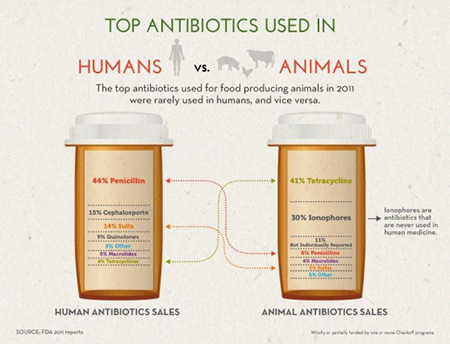The Food and Drug Administration (FDA) is implementing a voluntary program within the animal, feed and drug industries to phase out the use of certain antibiotics in the use of animal feed or drinking water. To date, all animal pharmaceutical companies have agreed to fully comply. Here’s what you need to know about the changes:
Antimicrobial resistance
Resistance is an important public health issue not only in this country but globally. Microbes have an incredible ability to mutate and adapt to their environment. In the presence of less-than-killing-doses of antimicrobials, resistance can and does develop. What that means is that the drugs we have today can eventually quit working if we don’t address this issue.
Changes to FDA Rules
In an effort to curtail antimicrobial resistance crossover from food animals to humans, the FDA is modifying how feed- and water-based antimicrobials are used in animal agriculture. FDA has identified medically important antimicrobial drugs that are used for both humans and animals and will restrict usage of these (See Table 1 for a complete list) from current practices. Luckily, the drugs most used in humans are least used in livestock and vice versa (See Figure 1).

Table 1. Breakdown of Antimicrobial Drugs Affected by Current FDA Proposals and Those Not Affected.
*Taken from Elanco publication USBBUNON01097: How is antibiotic use going to change under proposals but forth by the FDA?

Figure 1. An illustration of the relative use of various drugs for both human and animal purposes.
In a nutshell, the only thing that will go away completely is the use of these shared drugs in low doses for the enhancement of growth or feed efficiency. These shared drugs will still be available for treatment, control and prevention of disease in livestock. However, they will no longer be available over-the-counter (OTC) and will require a veterinary feed directive (VFD) – essentially a prescription for livestock. This means that your livestock will require veterinary oversight prior to the purchase of feeds, supplements and/or additives containing the targeted drugs. You or your veterinarian will provide your feed dealer with a VFD and both will be required to keep these on file for a specified period of time. There are specific rules that govern what is a valid veterinary-patient relationship, and the specific details are still being worked out.
An important detail to keep in mind is that use of animal-only drugs will not change. Animal-only drugs that you are able to purchase OTC today you will be able to continue to purchase OTC after these changes are implemented.
Timeline
Implementation is said to start “within 3 years” of the writing of the last FDA document. That places the start roughly in December of 2016. However, the specifics of this new program are still being worked out.
Preparation
So what can you do in the meantime? While all legal uses and combinations of drugs are still available OTC today, including drug claims for growth enhancement and improved feed efficiency, you might want to start preparing yourself prior to 2016.
- Producers can start looking into other options (perhaps switching from a shared use drug to an animal-only use drug) and also start discussions with their veterinarian and feed distributor on the coming changes. Stay in touch with your feed dealers as details emerge.
- Feed Dealers can start discussions with their customers, local veterinarians and vendors to foster a line of communication on making these changes. Keep up-to-date on developing details from your vendors or directly from FDA.
In summary, the proposed FDA voluntary program to restrict use of selected medically important drugs in animal feed and water is designed to help protect public health and keep both humans and animals safe and healthy. To learn more about these proposed regulations visit FDA’s website at http://www.fda.gov/forconsumers/consumerupdates/ucm378100.htm

